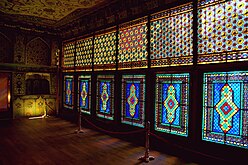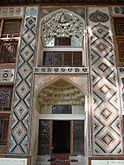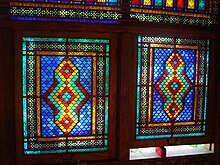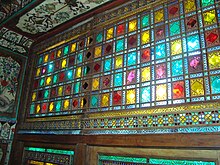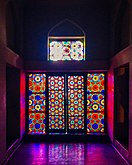Shabaka (window): Difference between revisions
Removed useless cathegory Tags: Visual edit Mobile edit Mobile web edit |
Added links Tags: Reverted Visual edit Mobile edit Mobile web edit |
||
| Line 15: | Line 15: | ||
The building of the [[Palace of Shaki Khans|Sheki Khans Palace]], shebeke fills walls, window openings of halls and rooms. Geometrically, shebeke windows fit with the general composition of the main facade of the palace. The continuous stained-glass shebeke-windows of the central halls and side rooms overlook the facade of the palace. It is believed that the replacement of the outer walls of the halls of the both floors and the upper rooms by lifting sashes-stained-glass windows is a feature of this ceremonial pavilion architecture.<ref>Л. С. Бретеницкий, Б. В. Веймарн. Искусство Азербайджана IV—XVIII веков. — М.: Искусство, 1976.</ref> |
The building of the [[Palace of Shaki Khans|Sheki Khans Palace]], shebeke fills walls, window openings of halls and rooms. Geometrically, shebeke windows fit with the general composition of the main facade of the palace. The continuous stained-glass shebeke-windows of the central halls and side rooms overlook the facade of the palace. It is believed that the replacement of the outer walls of the halls of the both floors and the upper rooms by lifting sashes-stained-glass windows is a feature of this ceremonial pavilion architecture.<ref>Л. С. Бретеницкий, Б. В. Веймарн. Искусство Азербайджана IV—XVIII веков. — М.: Искусство, 1976.</ref> |
||
== Shebeke art |
== Shebeke art == |
||
Shebeke as an art form was widespread in cities such as [[Shaki, Azerbaijan|Sheki]], [[Shusha]], [[Ordubad]], [[Baku]], [[Ganja, Azerbaijan|Ganja]], [[Lankaran]], [[Nakhchivan (city)|Nakhichevan]] and [[Derbent]].<ref name=":0">{{cite web |
|||
|url =http://www.fondartproject.ru/artprocess/iskusstvo-i-simvolika-shebeke/ |
|url =http://www.fondartproject.ru/artprocess/iskusstvo-i-simvolika-shebeke/ |
||
|archiveurl =https://web.archive.org/web/20160910171241/http://www.fondartproject.ru/artprocess/iskusstvo-i-simvolika-shebeke/ |
|archiveurl =https://web.archive.org/web/20160910171241/http://www.fondartproject.ru/artprocess/iskusstvo-i-simvolika-shebeke/ |
||
Revision as of 19:21, 5 March 2024
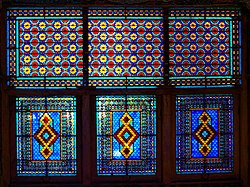
Shebeke are windows filled with coloured glass, created by folk craftsmen from small wooden parts without glue and nails.[1][2][3]
The building of the Sheki Khans Palace, shebeke fills walls, window openings of halls and rooms. Geometrically, shebeke windows fit with the general composition of the main facade of the palace. The continuous stained-glass shebeke-windows of the central halls and side rooms overlook the facade of the palace. It is believed that the replacement of the outer walls of the halls of the both floors and the upper rooms by lifting sashes-stained-glass windows is a feature of this ceremonial pavilion architecture.[4]
Shebeke art
Shebeke as an art form was widespread in cities such as Sheki, Shusha, Ordubad, Baku, Ganja, Lankaran, Nakhichevan and Derbent.[5] The main center of Shebeke art is Sheki, where this tradition is still presented in its pure, classic form. Samples of this kind of art dated with 18th-19th centuries are concentrated here. A classic example of this art form is the Sheki Khans Palace (1762). [6][7][8]
Shebeke art and its symbolism differ to some extent throughout the regions of Azerbaijan. For example, from the point of view of the manufacturing technology, the Ordubad craftsmen preferred the simplicity of the geometric shapes and an ascetic colour scheme. However, despite this, in the almost all regions of the country, the coloured glass is the main material.[5]
See also
Gallery
References
- ^ Мамед-заде, Камил (1983). Строительное искусство Азербайджана: с древнейших времен до XIX в. (PDF). Baku: Elm.
- ^ Azad Sharifov (1998). "Shaki: Paradise in the Caucasus Foothills". azer.com. Archived from the original on March 6, 2001. Retrieved June 18, 2021.
- ^ Александр Миловский. "Шебеке" (in Russian). vokrugsveta.ru. Archived from the original on August 30, 2009. Retrieved June 18, 2021.
- ^ Л. С. Бретеницкий, Б. В. Веймарн. Искусство Азербайджана IV—XVIII веков. — М.: Искусство, 1976.
- ^ a b Эртегин Саламзаде (May 12, 2014). "Искусство и символика шебеке" (in Russian). fondartproject.ru. Archived from the original on September 10, 2016. Retrieved June 18, 2021.
- ^ "Shaki-Paradise in the Caucasus Foothills". Azerbaijan International. 1998.
- ^ Л. С. Бретеницкий, Б. В. Веймарн. Искусство Азербайджана IV—XVIII веков. — М.: Искусство, 1976.
- ^ Самира Кязимова (July 17, 2013). "Волшебные витражи — без гвоздя и клея" (in Russian). Азербайджанские известия. Archived from the original on October 31, 2013. Retrieved June 18, 2021.

